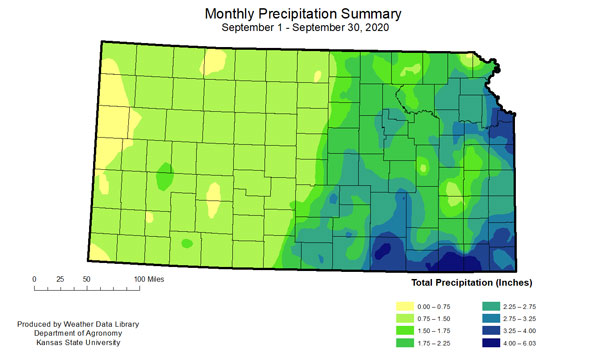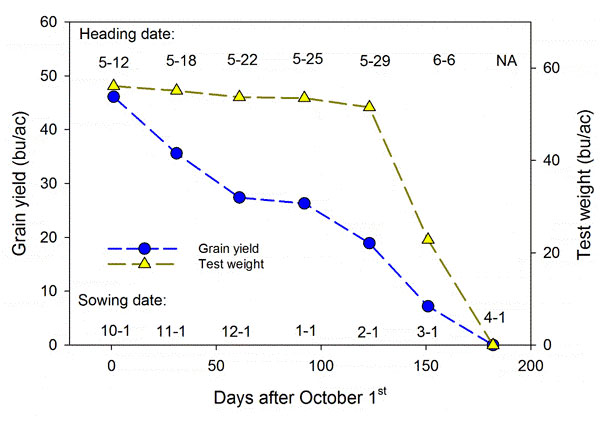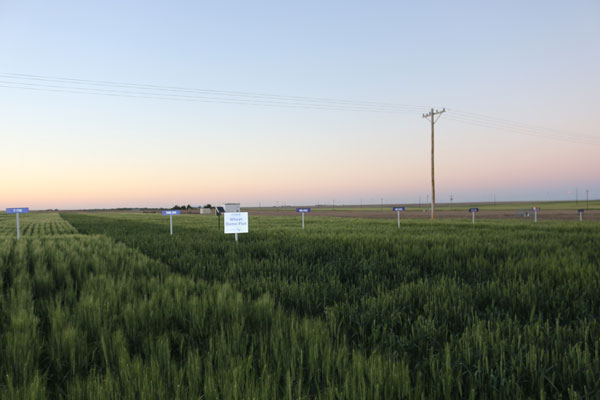Many fields in Kansas emerged late (from late October into November) during the 2020 growing season due to extremely dry conditions during the fall, especially in October when the bulk of the wheat is planted around the state. While some precipitation occurred until mid-September, October precipitation was mostly less than 0.5 inches for most of north-central and western Kansas and did not happen until the later portion of the month (Figure 1).


Figure 1. Total precipitation during the months of September and October 2020. Graph courtesy of the Weather Data Library.
Consequently, even wheat fields that were planted on a good timing resulted in a late-emergence. Late-emerged winter wheat has considerably less yield potential than a crop emerged at the optimum time. Producers will have to decide whether maintaining the crop is a viable option – especially as the late-emerged crop might be more exposed to winterkill from the recent cold temperatures (see the accompanying article on potential for winterkill).
Reasons for the generally observed decreased yield potential with a delay in sowing date include:
- Less fall tillering potential: fall-formed tillers are generally more productive than spring-formed tillers. When wheat is sown late, it will have less time to tiller in the fall, which decreases the production of higher yielding tillers as well as total tiller production.
- Delayed cycle: late sowing often delays the entire crop cycle as compared to a crop sown earlier. As a consequence, the grain filling period might occur a few days later and under hotter air temperature conditions, which decreases yield and test weight.
- Greater exposure to winterkill: a wheat crop with 3 – 5 fall-formed tillers has greater cold tolerance than a crop that has only one or two tillers. As a consequence, late-sown fields might be more exposed to winterkill, especially in dry conditions.
Research conducted by Merle Witt with late-sown wheat in Garden City from 1985 through 1991 is summarized in Figure 2. Averaged across all these years, delaying wheat sowing from October 1 to November 1 delayed heading date by 6 days and decreased wheat yields in 23%. The grain-filling period was progressively shortened by about 1.7 days and occurred under hotter temperatures (about 1.5°F) for every month of delay in sowing date.

Figure 2. Wheat grain yield, test weight, and heading date responses to sowing date between 1985 and 1991. Data adapted from Kansas Agric. Exp. St. SRL 107.
In summary, the potential consequences of the delayed progress of the Kansas wheat crop during October include greater exposure to winterkill, delayed crop cycle for grain filling under warmer conditions, and a lower yield potential due to decreased fall tillering. Research evaluating effects of weather conditions on long-term variety performance tests indicated that wheat yields were influenced the most by favorable precipitation conditions during the fall that promoted stand establishment and moist soil conditions (Holman et al. 2011). However, if the weather conditions during the remaining season are favorable (mild winter, and cool and moist spring), the crop might still result in decent a yield (Figure 3).

Figure 3. K-State wheat demonstration plot near Dodge City, KS, during June 2017. While this crop was sown normally during October 2016, it had not emerged in the fall due to extremely dry conditions. An ice storm on January 2017 sufficed for the crop to emerge, and favorable winter and spring weather conditions led to a decent yield potential despite harsh initial conditions.
Holman, J.D., A.J. Schlegel, C.R. Thompson, and J.E. Lingenfelser. 2011. Influence of Precipitation, Temperature, and 56 Years on Winter Wheat Yields in Western Kansas. Crop Management 10(1), available at: https://dl.sciencesocieties.org/publications/cm/abstracts/10/1/2011-1229-01-RS
Romulo Lollato, K-State Wheat and Forage Specialist
lollato@ksu.edu
Mary Knapp, Weather Data Library
mknapp@ksu.edu
Tags: wheat dry soils Drought delayed emergence yield potential